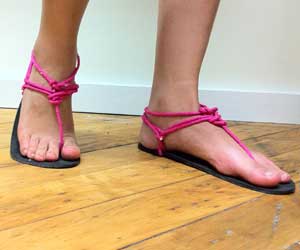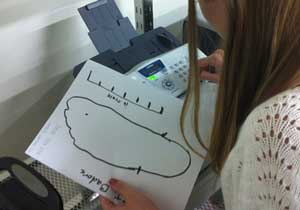My quest to find the perfect running shoe began with foot pain. My primary sport is figure skating, and the Pumas were great for off-ice training and workouts. But six years after purchasing them, the soles have worn smooth and I couldn’t run two days in a row due to aching arches.
Over the next few weeks, I’ll be posting reviews of running shoes. Before jumping in, I thought I would share a little of my background. I would describe myself as an amateur running enthusiast. I run about three times a week, rarely covering more than three miles. I participated in track in school, so do know something about proper running form. However, I am not an expert.
Invisible Shoes — Sandals for Barefoot Running
There’s a debate raging over barefoot running, and one way to participate in any debate is to get some first-hand experience in the matter. So when Steven Sashen from InvisibleShoe.com contacted me about trying a pair of barefoot running sandals, I jumped at the chance. They couldn’t hurt much worse that my old Pumas, right?
The “invisible” running sandals, also called huaraches, are light-weight sandals with very thin soles that lace to your feet. The lace is knotted at the ankles at the front of the foot, and the tension of the lace can be adjusted. They boast the same benefits of running barefoot, but with the added protection of a sole—so you can run on a wider variety of terrain. To obtain a pair of custom huaraches, I sent Steven a tracing of my foot, with marks indicating the location of my ankles and big toe.
Day 1
The shoes came with all the knots in place and I did not need to adjust the tension. I had a hard time figuring out what to do with the extra cord. Even after looking at the examples on the website, I still wasn’t sure I was doing it “right.” I later discovered that as long as the knots stay in place, what you do with the rest of the lace isn’t very important.
My target distance for each trial run is about two miles. At the start of my run, the shoes felt surprisingly comfortable and light. I was worried that the cord straps would move too much and cause blisters, but they didn’t rub at all. My first irritation was that I had to stop and adjust the knots on my left sandal several times. I didn’t bring the rather complicated instructions on how to tension them with me, and the knot on the instep slipped down as I ran, causing the shoe to loosen. After about a mile, my left sandal gave me the unpleasant impression of having the sole of my foot slapped. At a mile and a half, my left instep hurt. Heeding Steven’s caution to take it easy at first and pay attention to pain, I walked the rest of the way home.
Even in Williamsburg, Brooklyn, the home to many wild fashions, I did get quite a few stares. I got as much attention from the loud slapping of the shoe against the concrete as much as the actual sight of someone running in sandals. If working out makes you feel self-conscience, these are not the shoes for you, they will draw attention.
Day 2
After a few days to rest and recover, I took my barefoot sandals out for a second run. This time went much better with the knots, and I didn’t have to make any stops to adjust. However, I did have to stop twice to get gravel out of my shoe.
I made my two miles without any further trouble. However, within an hour of my run, I realized that my feet were sore, although no more so than after running in my old Pumas.
Day 3
I was unwilling to run sore-footed, so I gave my feet a full week to recover. For the third run, I paid more attention to my form and ran at a slightly slower pace. I made it through two miles pain-free, nor did my feet hurt after the run.
Conclusion
Compared to Vibram’s FiveFingers, these shoes are a less expensive option, although at nearly $50 not exactly cheap. I found the laces on these shoes very fussy. I did like the lightweight feel of running next-to-barefoot, which in a fairly short time I could do without sore feet. Although the shoes do provide some protection for the soles of your feet, you still need a fairly clean and smooth running surface. Also, I have some doubts about the long-term quality of these shoes. After only about six miles, bits of the inside of the laces are starting to show.
Also Read:


